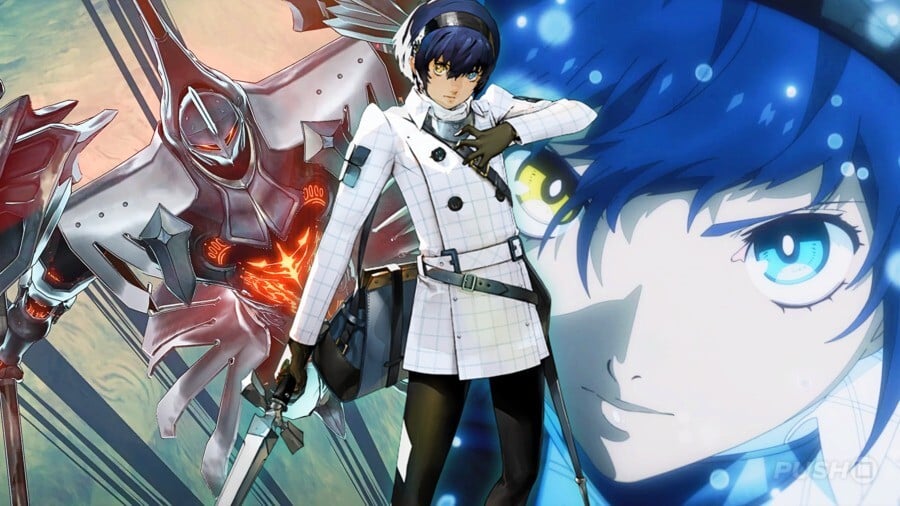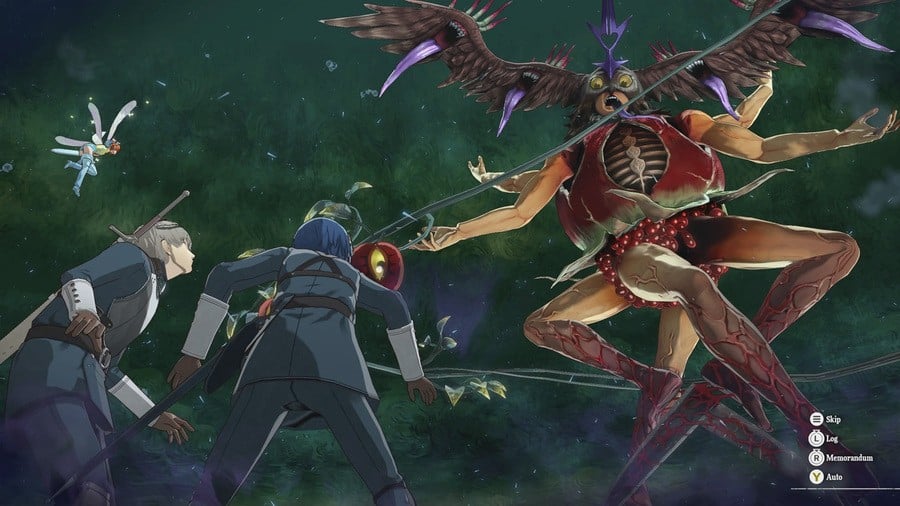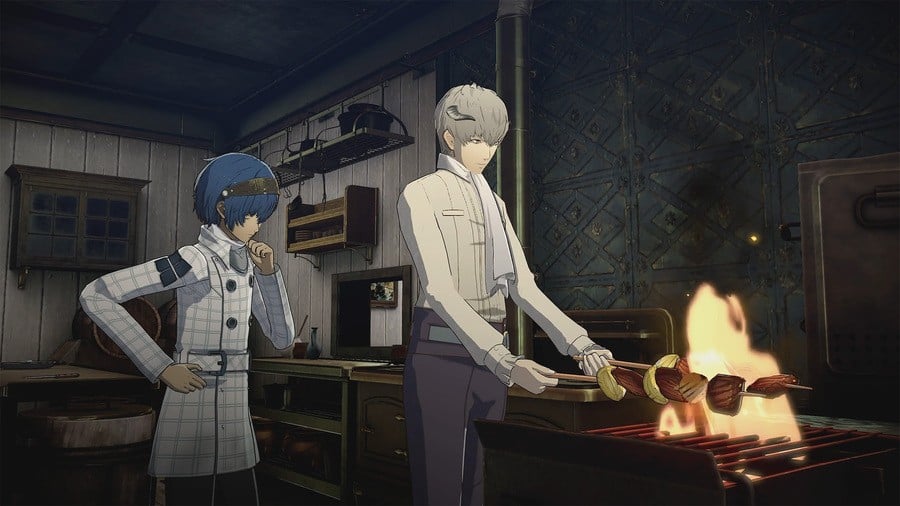
Metaphor: ReFantazio is a lot. We were only allowed to spend around an hour with Atlus’ upcoming RPG at this years’ Summer Game Fest, but in that time, we ran into egg enemies wearing boots; we acted like an ass to our other party members; we made kebabs with one of or companions; we also fought squid Jesus which had a heart for a head.
It’s not an exaggeration to say that Metaphor: ReFantazio is dripping in excess, then. It’s also ridiculously stylish, almost noisily, but it pulls it off with such confidence. Text boxes are fractured, and both enemies and characters get colourful transitions between turns. The game does all of this effortlessly, all while taking place in some blended Neo-Medieval world which mixes high fantasy with steampunk with skyscrapers. We can’t think of another game that’s been this confident and stylish since, well, Persona 5.
Subscribe to Push Square on YouTube166k
We know that’s really cliche to say, but Atlus’ first new IP in years does feel like it borrows from the developer’s Persona series the most. Importantly, it also feels like a culmination of not just Persona, but everything the company has ever developed in its 35 year history. It’s weird, loud, beautiful, and full-to-bursting with things to do. We think that it’ll appeal to not just Persona fans, but anyone into turn-based RPGs in general.
From what we saw of the world, it feels so different to anything Atlus has ever made before. Huge towering buildings – of which we only saw through flashbacks and additional trailers. A city walled off from a vast, barren landscape a la Attack on Titan. A gigantic Masoleum dungeon with crumbling brickwork and dilapidated structures within. There are also cosy hamlets with cobbled streets and brick stone buildings. After becoming so familiar and adjusted to the modern-day settings or post-apocalyptic worlds of Persona and Shin Megami Tensei, Metaphor: ReFantazio feels so fresh. We can easily say there’s nothing else like the United Kingdom of Echronia.
There are plenty of differences from Atlus’ other series that set Metaphor apart. One is the protagonist, who you get to name and select dialogue choices as you would in Persona, but this time, he’s fully voiced. And at least during the English voice track – which, by the way, is sounding fantastic – we heard multiple different accents, from American, to Irish, to Liverpudlian. It’s a real breath of fresh air and, mix that with a variety of character designs, body types, and skin tones, and this feels like a fantastic step forward character-wise.
This peppering of new ideas and systems carries through into combat. Metaphor builds off of the press-turn system that we’ve become accustomed to in so many interesting ways. Even the way you initiate combat is important. You can attack an enemy on the field to whittle down their health – if weaker, you can actually defeat them on the field, but if they’re stronger, you’ll eventually stun them, giving you an advantage in battle.

Regardless of how you enter a fight, once you hit the ‘Squad’ button, you and your party will line up for turn-based action. This is where Archetypes, the game’s job system, come into play. We only got to play with a handful of these, but there will be over 40 in the full game. Seeker is the protagonist’s base class which focuses on wind-based combat. Warrior, the noble Strohl’s starting class, is a high-damage job that can hit multiple enemies with sword slashes. Dancer is more about supporting the party and providing buffs and resistances. And all of these Archetypes have their own ‘Lineage’ – essentially, a job tree where these classes can evolve. Seeker’s last stage is the Soul Hacker, and honestly, we’re in love with these little callbacks.
Archetype skills range from big AOE damage moves to elemental spells, buffs, and heals – everything you’d expect in an RPG. But you can also see the passive skills each Archetype provides during combat, and these give stat buffs or increased elemental resistances, for instance. Skills, at least in the demo, were all relatively low MP cost, so the game is clearly encouraging you to use these extremely useful attacks to exploit enemy weaknesses and get those free turns.
Another new wrinkle comes with Synthesis, which sees two characters team up for a more powerful attack. These attacks often consume more than one turn – inducated by the crystals in the top left of the battle screen – but they’re almost always worth it. And the Synthesis skills available to you are determined by the characters in your party, the Archetypes equipped, and even the formation of your team. Our favourite little detail in combat is the fact you can change a character’s position by pressing up or down on the d-pad, and it doesn’t consume a turn! That’s pretty exciting for any RPG nut.
We love the combat, but we also admit that, with all of the visual noise, the new skills, and everything else going on, that it’s hard to get to grips with in a short space of time. The amount of options is pretty overwhelming, but it only makes us more eager to dig into all of the nuances and things we didn’t get to experience, like job progression, class swapping, and even more party compositions.
Against the demo boss – a huge sea beast that, yes, is a big kraken wearing a thorn crown – is where Synthesis skills came in handy. The beast has four tentacles that you have to take out to weaken the head, and Heismay, who came equipped with the Mage archetype, had access to all of the elemental spells. We quickly realised the boss was weak to Electric, and using Synthesis meant Heismay could use Kande (the electric spell) to attack all the tentacles and the boss and grant a free extra turn.
After getting rid of the tentacles, we then spent a turn buffing our protagonist before using Synthesis with him and Strohl for a powerful chariot attack. Some of these Sytthesis moves fit the brief for Metaphor to a tee – excess, over the top, and sometimes hilarious. Seeing the Seeker stand proudly atop a chariot with his sword pointing outward is so ridiculous but so epic. It was also a refreshing change of pace to find that this boss wasn’t a pushover, and we barely lost due to a late-fight mechanic that gave the monster four turns in one go.

Our time with Metaphor was spent mostly in combat or exploring the Mausoleum dungeon, but there are plenty of other new features that we spotted. Fae Sight allows you to check an enemy’s level and “power” from a distance – if they’re blue, they’re weak; yellow means they’re about your level; red means they’re stronger than you. The dungeons also feel much different from Palaces or any other dungeon Atlus has ever crafted – bigger, with more branching paths and optional sections. We even picked up a quest right at the entrance to help a girl rescue her friend.
But the biggest change was during one of the few moments of downtime on board a steampunk-esque ship. Before a boss fight, we were allowed to spend our time with one of our friends, building our own 'social' stats. We could sharpen our swords with Strohl or read books with the fairy Gallica. We chose to make kebabs, which not only gave us food to consume, but also boosted a social stat. There also seems to be an entire cooking mechanic, with multiple recipes to collect, and specific ones can only be made with certain party members.
Frankly, an hour isn’t enough time to grasp everything Metaphor: ReFantazio is trying to do. It’s brash, bold, and brilliant in many ways, but it’s also a lot to take in – overwhelmingly so. The visuals, while fantastic, can sometimes drown out some of the text during fights. And there are lots of new systems involved that it’ll definitely take a while to ease into combat. But even with all that, Metaphor is truly shaping up to be an incredibly addictive RPG. We want to know more about the story, the characters, the world, and even the bonds you’ll forge, but even from just the combat alone, this could be one of 2024’s best games.
Are you excited for Metaphor: ReFantazio? Get metaphorical with us in the comments.





Comments 36
Thanks for making the wait even more unbearable Alana, really appreciate it.
I am going to stop reading about this game. I want to know less and Atlus is always so good at giving us so much information that it's starting to get into spoiler territory...lol...
Between this, Visions of Mana, Astro Bot and YS X Nordics, this second half of the year is looking really good for me.
Didn't think I could get more cheesed on this game but here we are. Great write-up!
Peak incoming
@UltimateOtaku91 Trails through Daybreak too
Trails through Daybreak also has the fight and kill weaker enemies realtime and then initiate the turn based whenever you want. I really like this mechanic to quickly get through enemy fodder and enjoy the turn based when needed!
This looks great, but I'm a bit unsure, as this definitely won't escape Atlus' shady practices.
Can't wait for this game, Alana picked up on the one small negative I noted the first time I watched the original trailer - lots going on on the screen, looks a bit overwhelming! Don't think it'll affect the enjoyment too much though.
Oh god. Persona 3 Reload, YS X, Trails through Daybreak, Eiyuden Chronicles and now this too?! My poor, poor backlog...
And here I am still trying to complete Ni no Kuni 1 again for the first time in years lmao
We are eating so good on the JRPG side of things!
@MUG3NHC
I will buy this day one and be part of the problem...lol...I will also buy the ReElected GOTY edition with all the DLC and a different cover, hopefully in a steel book.
@MikeOrator
At least you're aware of the problem🤣
@ShogunRok @AlanaHagues Is the MC a girl or guy? I honestly can't tell from the screenshots lol. In any case this game looks phenomenal! 🤓
Not at all surprising.
The MC really is as bland they can get…but the more I read about the rest of the game and its systems the more I am intrigued .
Quite a big article, nice. This has been on my day 1 buy list since it was first announced.
Sounds very promising!
Automatic Day 1 buy
@WiiWareWave The protagonist's male, but he seems to be quite young.
Token comment about waiting for the 'royale/golden/etc ' version...
@ShogunRok Ugh. Same feeling here. The rest of the year is going to be low on AAA titles, to begin with, so this makes it even worse to have to wait.
I don't get the appeal at all. It looks fine, I still don't get it.
They aren't my type of game usually (I do like to still look at other games just encase to know what's out there) but at the same time other than Atlus fans having it good I mean good for them. Shrugs. I enjoyed Catherine so I understand their quality but their others games weren't my thing.
If it's coming out this year, then it's competing with 2 other games by the same dev, and another game by the same company. Tho I would want like a dragon infinite wealth to win game of the year. It is the best game I've played, but sadly not everyone knows about it.
I don't really like that you get to name the character if you can't create the character.
Have both this and SMT V: Vengeance preordered and paid already. I've been studiously avoiding new releases, but there's no way I wasn't grabbing a gigantic new Atlus JRPG like this on day one.
I want to get this game on day 1 but hesitate since Atlus has a bad habit of releasing 'complete edition' with new contents + DLC after a year.
I hope the story's good. The school setting in Persona never really captured my attention..
@CutchuSlow Infinite Wealth is one of my most anticipated games this year! (Because I’m currently on Y4 😂)
@personauser93 hahaha me too!! Started Y4 this month hahah
This one got me very excited. Atlus has immense pedigree, Persona 5 is one of the best JRPGs ever made, so for sure Metaphor will be great too!!
I'm excited for this and it'll likely be a day one buy for me, but man is the color palate for some of the environments in this game dull as dishwater. So much gray and brown. And a number of the archetypes like really same-y.
@freddquadros A fellow journeyman! For my sanity I’m only doing the main story for each game then going back to do the completion stuff once I’m caught up 😂
@personauser93 I'm doing some substories and the storylines that are more developed, like the Cabaret Clubs, Majima Constructions, the hitman missions in Y3... I won't complete everything those games has to offer, it's too much, for real hahaha It's really a huge, packed franchise, and I think they are the best storytellers of the medium today.
The big disappointment for me is the lack of romance, but I am sure i would enjoy all other aspects of the game.
Looks sweet, but it's Atlus, so I will get around to it when it's finished.
Show Comments
Leave A Comment
Hold on there, you need to login to post a comment...